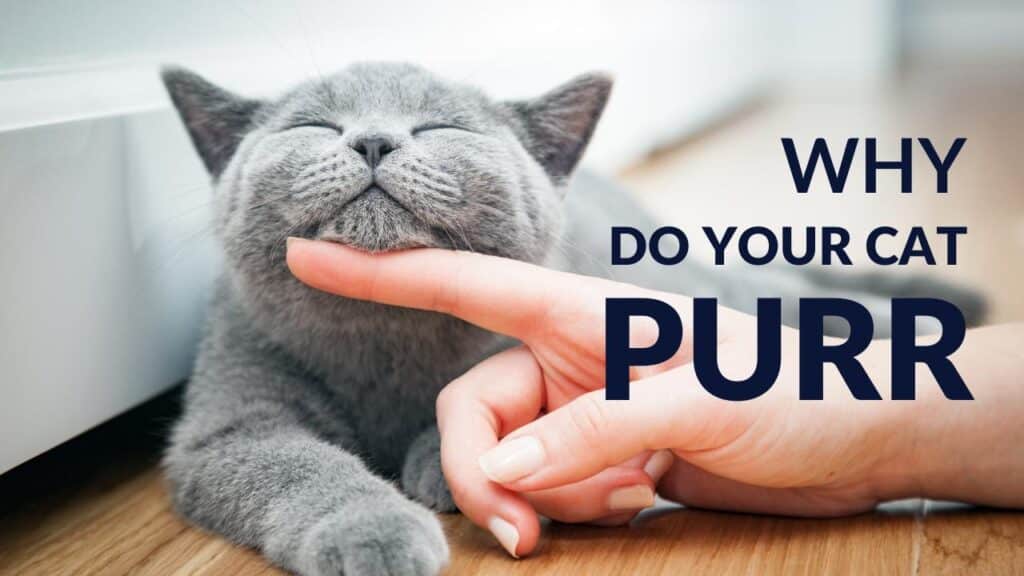Last Updated on April 28, 2024 by themubbi63
Cats make a variety of sounds, from meowing and chirping to hissing and growling. However, the most common sound of a Cats Purr sound. We’re often told that purring is a sign that the cat is happy and relaxed. And yes, that is true.
But cats can purr for a variety of other reasons, including when they’re hurt or feeling stressed or anxious. The soft, gentle vibrations feel just as soothing to them as it does to us. So what exactly are the reasons that cats purr? What are they trying to tell us when they make that pleasant rumbling sound?
Reasons of your Cats Purr
Mother-Kitten Bond
Kittens, like many other baby mammals, are born completely blind and deaf. For the first week of their life or so, they’re absolutely defenseless and at the mercy of their mother. Their very first mode of communication with their mothers is by purring.
They begin to gently purr when they’re just a few days old. It allows them to communicate with their mother, to let them know where they are and that they’re alright. Purring gets them their mother’s attention during feeding time and the mother too can purr back as a lullaby.
Thus, purring is one of the first bonding exercises between a kitten and a mama cat.
Related Article: Unveiling Unique Cat Breeds: From Hairless Wonders to Owl-Eared Cuties 2024
Your Cat Is Happy
The most common reason for purring, of course, is because the cat is happy and content. If your cat is lying on your lap and purring away or lying in the sun and purring gently, it probably means that the cat is supremely content. Usually, this is accompanied by a relaxed posture, closed eyes and a still tail.
Cats also purr when humans are stroking them and petting them because they feel comfortable. They are communicating their affection for you. The purr might be an indication for you to go on stroking them.
If they’re seeking you out, rubbing against you or cuddling up to your chest while purring, it means that your cat wants your pets. The purr is like the cat’s version of a smile.
It Wants Food (Or Something Else)
This is one of the hangovers from their kitten days when they purred to let mama cat know they wanted food. You might notice your cat purring around mealtimes. This is a demand for food. If they’re actively rubbing against your leg and accompanying their purring with meows, your cat probably wants dinner.
Research shows that the purring that marks a demand for food is significantly different from happy purring. It’s often accompanied by mewls and may even sound like a crying human baby. If you pay careful attention, you’ll be able to figure out the difference.
Self-Soothing Behavior
One thing that may surprise a lot of people, including pet owners? Cats often purr when they’re anxious or injured. It’s a self-soothing behavior. Purring takes energy but cats still do it when they aren’t feeling a hundred percent. It’s like a child sucking their thumb even when they’re tired or cranky.
In fact, people believe that the purring of a cat often has healing powers, both for themselves and for humans. Purring takes place at a frequency of 25 and 150 hertz, which is the same frequency that is used to heal bones and fractures, rebuild muscles and repair tendons, ease breathing and lessen pain.
Thus, maybe it’s not unbelievable that an injured and anxious cat is able to heal itself by the sound of its gentle purring. If it’s battling a fever or infection, it might soothe itself by purring.
Looking for your pet care? read this: Milk for Cats? Myth Busted! The Truth About Lactose Intolerance 2024
To Greet You
If your cat greets you at the door with a purr when you come home from work or someplace else, that might just be the cat saying its own form of hello. This may be accompanied by the cat rubbing itself against your body or running to your feet.
Really, the body language of the cat can tell you just as much as the purring itself can about how your cat is feeling. And the difference between happy and distressed purring isn’t difficult for pet owners to understand.
Conclusion
Cats may not speak our language, but their purrs speak volumes! From a kitten’s first gurgle to a gentle greeting at the door, purring offers a window into your cat’s world. Understanding these rumbling messages strengthens the bond between you and your feline friend.
FAQs
Why does my cat purr at feeding time?
Kittens purr to tell their mother it’s time to eat. This behavior might carry over into adulthood, with purring becoming a way to request food from you.
How can I tell if my cat’s purr is happy or stressed?
Look for body language! Relaxed posture, closed eyes, and a gentle purr usually signal contentment. Anxious purrs might be accompanied by pacing or dilated pupils.
Can purring heal humans?
Some believe the purring frequency helps heal bones and muscles. While research is ongoing, the calming effect of purrs can surely reduce stress in humans.
